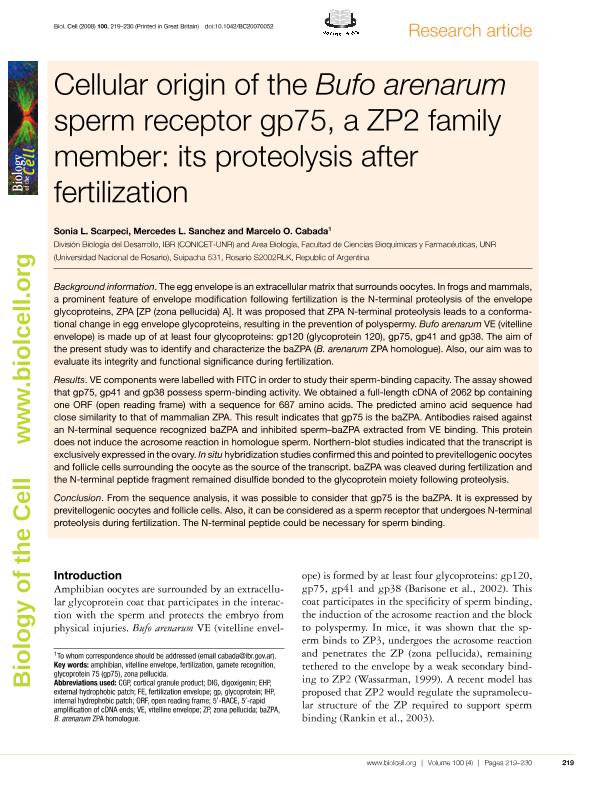Mostrar el registro sencillo del ítem
dc.contributor.author
Scarpeci, Sonia Laura

dc.contributor.author
Sánchez, Mercedes Leonor

dc.contributor.author
Cabada, Marcelo Oscar

dc.date.available
2019-08-01T14:57:56Z
dc.date.issued
2008-04
dc.identifier.citation
Scarpeci, Sonia Laura; Sánchez, Mercedes Leonor; Cabada, Marcelo Oscar; Cellular origin of the Bufo arenarum sperm receptor gp75, a ZP2 family member: Its proteolysis after fertilization; Portland Press; Biology Of The Cell; 100; 4; 4-2008; 219-230
dc.identifier.issn
0248-4900
dc.identifier.uri
http://hdl.handle.net/11336/80727
dc.description.abstract
Background information. The egg envelope is an extracellular matrix that surrounds oocytes. In frogs and mammals, a prominent feature of envelope modification following fertilization is the N-terminal proteolysis of the envelope glycoproteins, ZPA [ZP (zona pellucida) A]. It was proposed that ZPA N-terminal proteolysis leads to a conformational change in egg envelope glycoproteins, resulting in the prevention of polyspermy. Bufo arenarum VE (vitelline envelope) is made up of at least four glycoproteins: gp120 (glycoprotein 120), gp75, gp4l and gp38. The aim of the present study was to identify and characterize the baZPA (B. arenarum ZPA homologue). Also, our aim was to evaluate its integrity and functional significance during fertilization. Results. VE components were labelled with FITC in order to study their sperm-binding capacity. The assay showed that gp75, gp4l and gp38 possess sperm-binding activity. We obtained a full-length cDNA of 2062 bp containing one ORF (open reading frame) with a sequence for 687 amino acids. The predicted amino acid sequence had close similarity to that of mammalian ZPA. This result indicates that gp75 is the baZPA. Antibodies raised against an N-terminal sequence recognized baZPA and inhibited sperm-baZPA extracted from VE binding. This protein does not induce the acrosome reaction in homologue sperm. Northern-blot studies indicated that the transcript is exclusively expressed in the ovary. In situ hybridization studies confirmed this and pointed to previtellogenic oocytes and follicle cells surrounding the oocyte as the source of the transcript. baZPA was cleaved during fertilization and the N-terminal peptide fragment remained disulfide bonded to the glycoprotein moiety following proteolysis. Conclusion. From the sequence analysis, it was possible to consider that gp75 is the baZPA. It is expressed by previtellogenic oocytes and follicle cells. Also, it can be considered as a sperm receptor that undergoes N-terminal proteolysis during fertilization. The N-terminal peptide could be necessary for sperm binding.
dc.format
application/pdf
dc.language.iso
eng
dc.publisher
Portland Press

dc.rights
info:eu-repo/semantics/openAccess
dc.rights.uri
https://creativecommons.org/licenses/by-nc-sa/2.5/ar/
dc.subject
Amphibian
dc.subject
Fertilization
dc.subject
Gamete Recognition
dc.subject
Glycoprotein 75 (Gp75)
dc.subject
Vitelline Envelope
dc.subject
Zona Pellucida
dc.subject.classification
Biología Celular, Microbiología

dc.subject.classification
Ciencias Biológicas

dc.subject.classification
CIENCIAS NATURALES Y EXACTAS

dc.title
Cellular origin of the Bufo arenarum sperm receptor gp75, a ZP2 family member: Its proteolysis after fertilization
dc.type
info:eu-repo/semantics/article
dc.type
info:ar-repo/semantics/artículo
dc.type
info:eu-repo/semantics/publishedVersion
dc.date.updated
2019-07-29T14:50:25Z
dc.journal.volume
100
dc.journal.number
4
dc.journal.pagination
219-230
dc.journal.pais
Reino Unido

dc.journal.ciudad
Londres
dc.description.fil
Fil: Scarpeci, Sonia Laura. Consejo Nacional de Investigaciones Científicas y Técnicas. Centro Científico Tecnológico Conicet - Rosario. Instituto de Biología Molecular y Celular de Rosario. Universidad Nacional de Rosario. Facultad de Ciencias Bioquímicas y Farmacéuticas. Instituto de Biología Molecular y Celular de Rosario; Argentina
dc.description.fil
Fil: Sánchez, Mercedes Leonor. Consejo Nacional de Investigaciones Científicas y Técnicas. Centro Científico Tecnológico Conicet - Rosario. Instituto de Biología Molecular y Celular de Rosario. Universidad Nacional de Rosario. Facultad de Ciencias Bioquímicas y Farmacéuticas. Instituto de Biología Molecular y Celular de Rosario; Argentina. Provincia de Entre Ríos. Centro de Investigaciones Científicas y Transferencia de Tecnología a la Producción. Universidad Autónoma de Entre Ríos. Centro de Investigaciones Científicas y Transferencia de Tecnología a la Producción. Consejo Nacional de Investigaciones Científicas y Técnicas. Centro Científico Tecnológico Conicet - Santa Fe. Centro de Investigaciones Científicas y Transferencia de Tecnología a la Producción; Argentina
dc.description.fil
Fil: Cabada, Marcelo Oscar. Consejo Nacional de Investigaciones Científicas y Técnicas. Centro Científico Tecnológico Conicet - Rosario. Instituto de Biología Molecular y Celular de Rosario. Universidad Nacional de Rosario. Facultad de Ciencias Bioquímicas y Farmacéuticas. Instituto de Biología Molecular y Celular de Rosario; Argentina
dc.journal.title
Biology Of The Cell

dc.relation.alternativeid
info:eu-repo/semantics/altIdentifier/url/https://onlinelibrary.wiley.com/doi/full/10.1042/BC20070052
dc.relation.alternativeid
info:eu-repo/semantics/altIdentifier/doi/https://doi.org/10.1042/BC20070052
Archivos asociados
